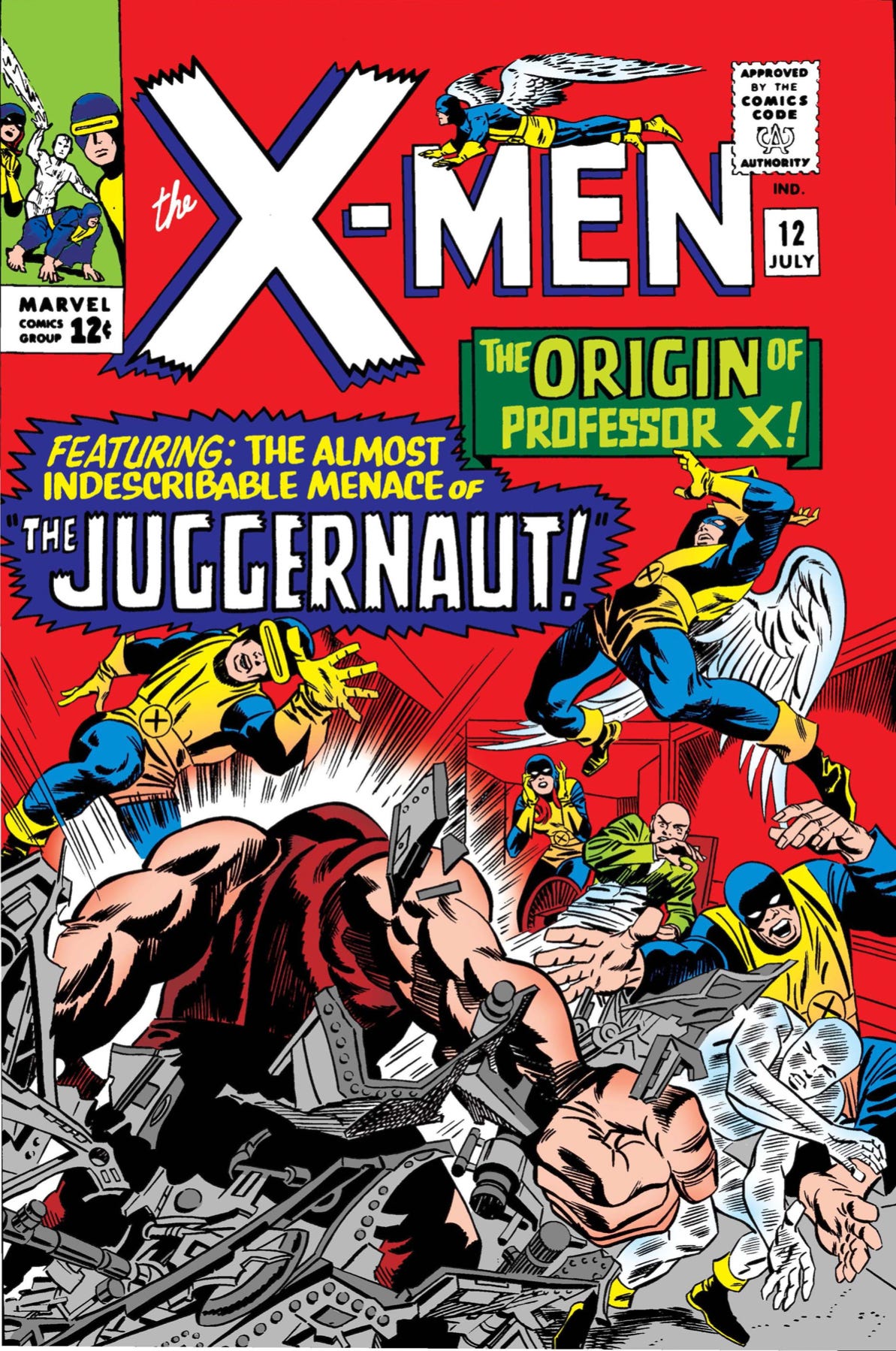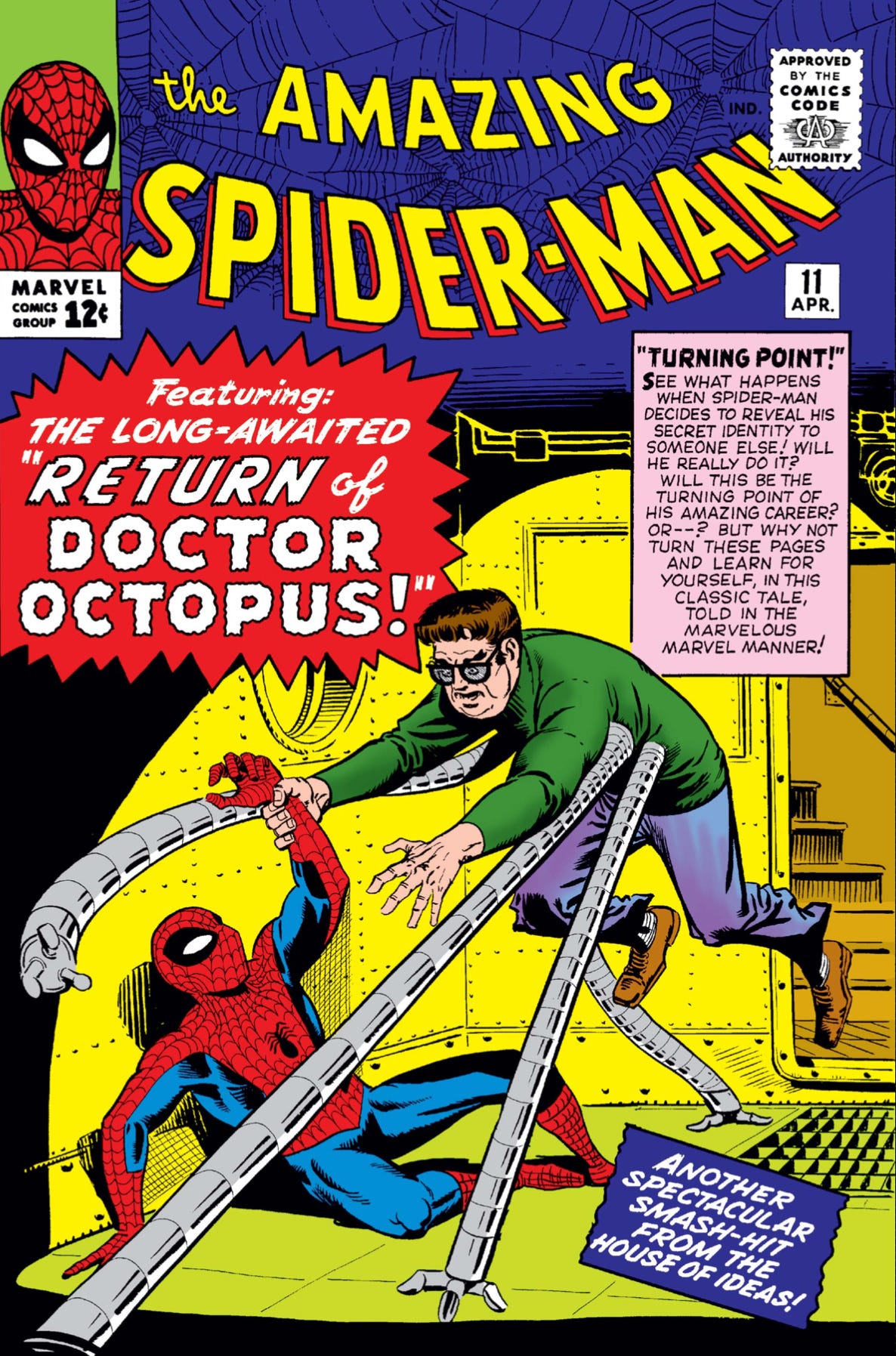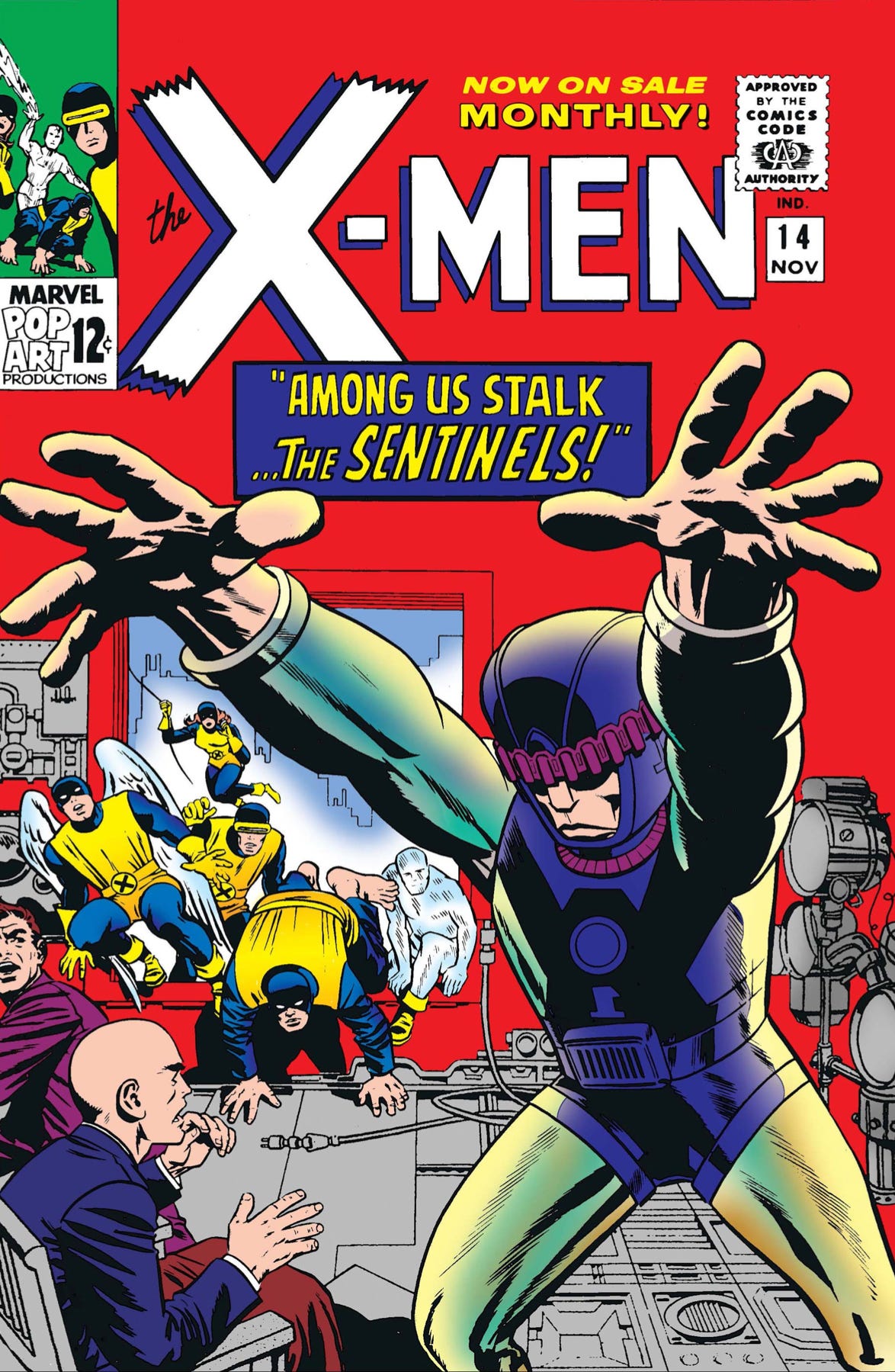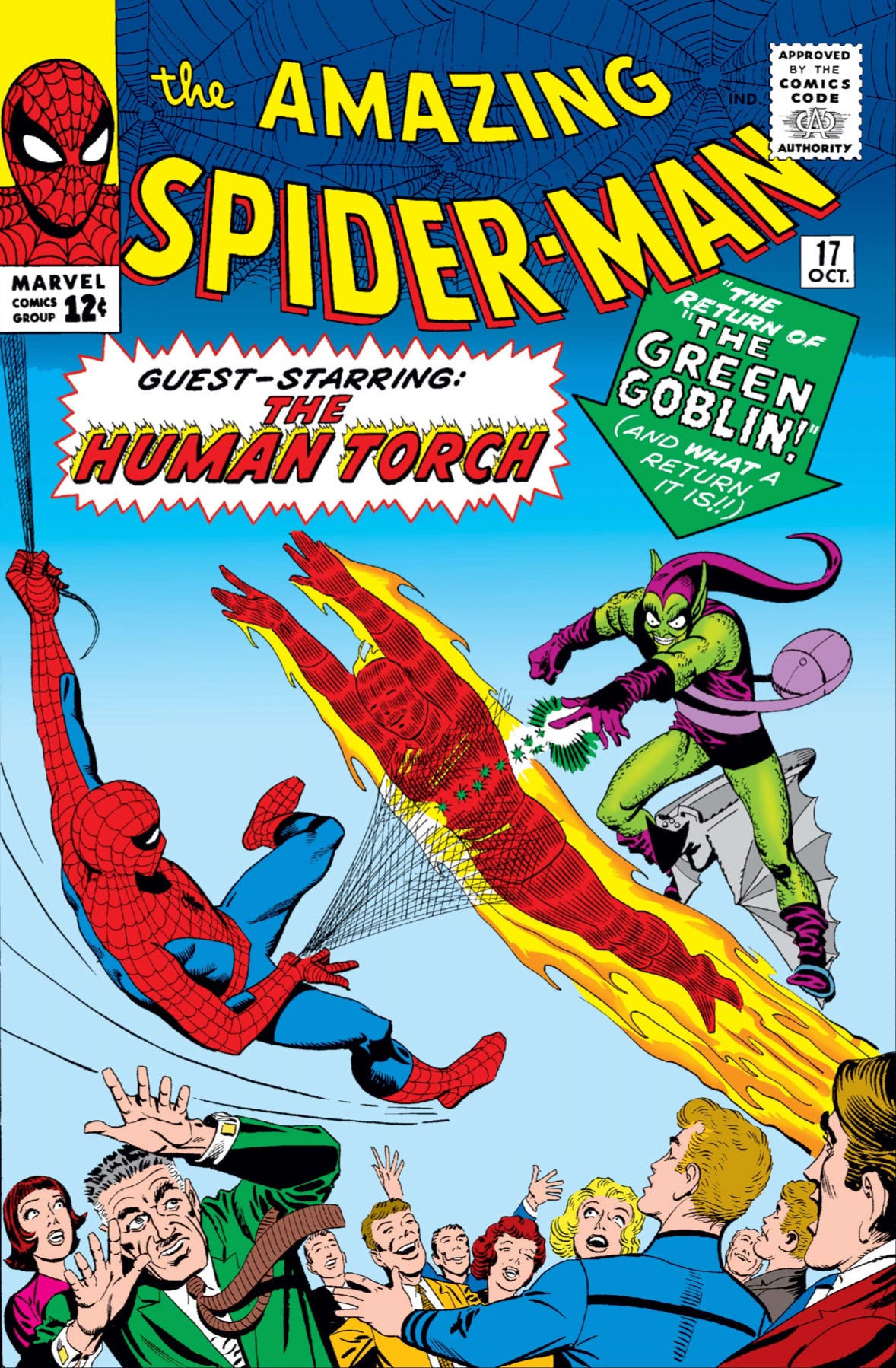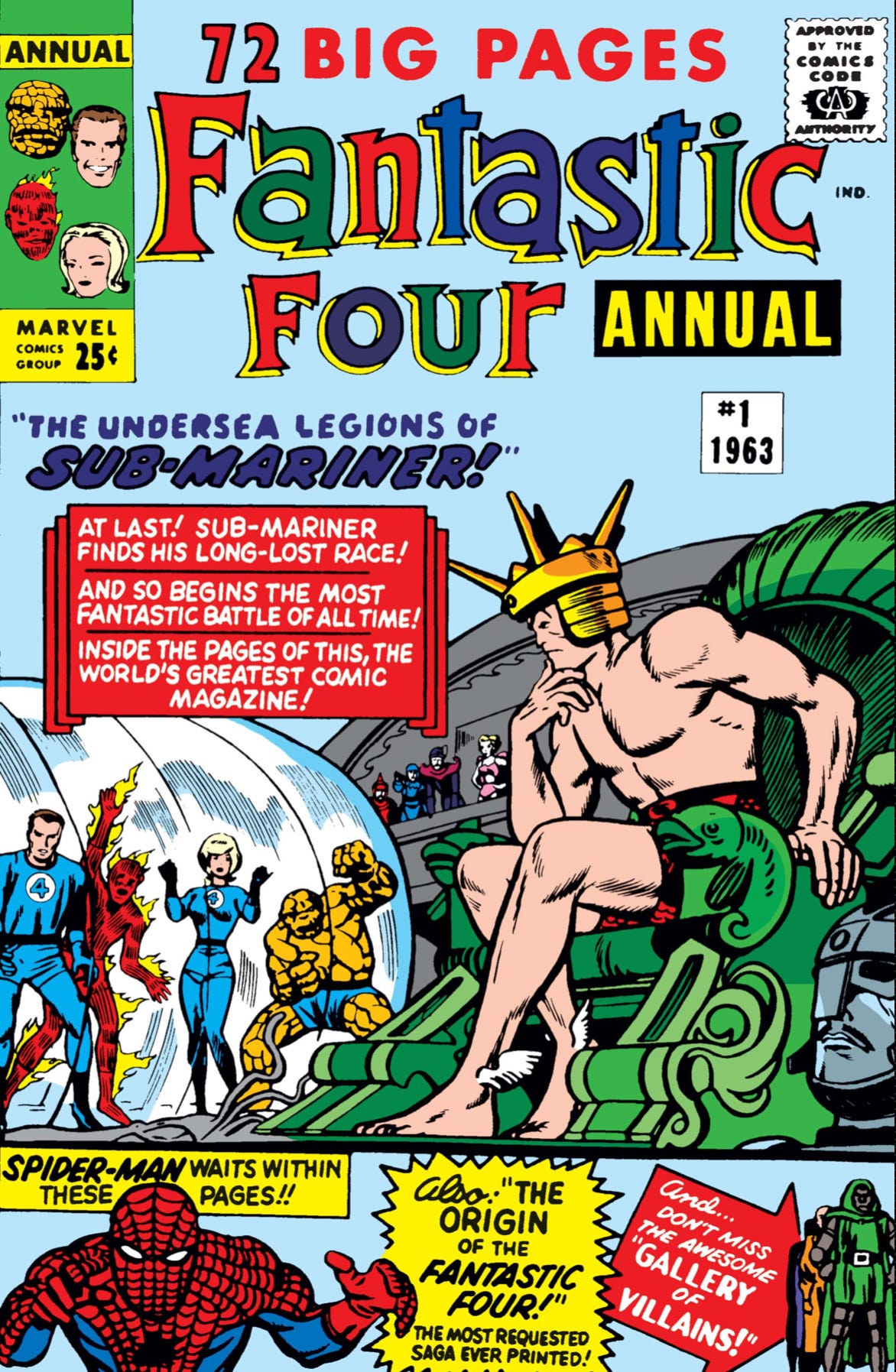Name the top ten Marvel Comics stories of all time.
Nope. Too difficult. Too many great comics over the decades.
Name the top ten Marvel Comics of each five-year period since 1961.
Okay, this is more manageable, and it will allow for proper apples-to-apples comparisons. The comics medium has changed quite a bit over the years, so it’s hardly fair to compare, say, ten-year-old comics to fifty-year-old comics.
It will take me a while to work through each period, but let’s get started with 1961-1965. (Each period is defined by release date, not cover date.)
So, we begin at the dawn of the Marvel Universe. True, many books from this era don’t hold up particularly well, not to the adult reader. They are dated indeed. But in the foundation of each series are strong, enduring concepts and flawed but heroic characters that people of varied backgrounds can relate to. Plus, the old comics offer plenty of charm with their fast-paced displays of free-flowing imagination. Looking back on these early issues, it’s not hard to see why the characters have survived the decades.
(Spoilers ahead, but these came out over five decades ago, so…)
10) The Amazing Spider-Man #3 (by Stan Lee and Steve Ditko)
The superhero genre often follows a simple but effective formula: The hero almost loses to the villain but ultimately prevails, often improving himself or herself along the way. Doctor Octopus’s debut shows an early example of that formula in action, back when flawed superheroes were still a fresh idea. As the book opens, Spider-Man is feeling supremely confident in his crimefighting abilities, and he’s itching for a challenge.
He gets one, and he gets clobbered, leading Peter to wonder if he’s even cut out for this superhero lifestyle after all. He’s got a choice: quit, or try again but do it better this time.
Peter Parker is still growing into his role at this stage, and that’s part of what made this series so novel—the superhero was actually growing as a person.
And we haven’t seen the last of Spider-Man on this list. The Amazing Spider-Man was easily Marvel’s strongest series of this era.
9) X-Men #12 (By Stan Lee, Jack Kirby, and Alex Toth)
The X-Men, however, was not Marvel’s greatest hit back then. Their best days were ahead of them, but they had a couple of gems among their early issues. One was the debut of Professor Xavier’s evil stepbrother, the Juggernaut.
Juggernaut is like a precursor of Jaws here. The X-Men know he’s on his way to their mansion, and Professor X warns them of his stepbrother’s tremendous power. Much of the issue is divided between the X-Men preparing for his arrival, and Professor X sharing his family history. Meanwhile, a shadowy figure easily plows through the mansion’s defenses.
It’s an issue of build-up, establishing a serious physical threat and setting the stage for an action-packed showdown. The next issue isn’t quite as strong, but the tension in part one is excellent.
8) Daredevil #7 (by Stan Lee and Wally Wood)
One of the great Marvel concepts Stan Lee pioneered was casting the superhero as the underdog, thereby raising the stakes and making the character all the more heroic.
The plot of Daredevil #7 is a bit ridiculous. Namor the Sub-Mariner wants to sue the human race so Atlantis can claim dominion over the surface world, and the first law firm he finds is, naturally, Nelson & Murdock.
But when things don’t go Namor’s way, he goes on a rampage, and here’s where the book becomes an early classic. Daredevil realizes that an all-out battle between Namor and the U.S. Army would result in countless casualties, so he takes it upon himself to prevent that from happening. However, “taking it upon himself” means volunteering to fight a super-strong, flying monarch one-on-one. And recall—Daredevil is an athletic blind man with enhanced senses and no other powers.
Daredevil loses the battle but achieves his objective of saving lives, and he thereby earns Namor’s sincere respect—and the reader’s.
7) The Amazing Spider-Man #11-12 (by Stan Lee and Steve Ditko)
Spidey’s back on the list, and so is Doc Ock, this time in a two-parter that shows the Lee-Ditko team really finding their groove. Peter Parker’s troubles intersect with Spider-Man’s when he finds his girlfriend Betty Brant picking up Doctor Octopus from jail.
Secret-identity issues are at the core of this action/soap-opera blend. Peter resolves to tell Betty he’s Spider-Man, but tragedy interferes! He fights Doctor Octopus while sick, so Doc Ock easily overpowers him … and unmasks him! No one believes Peter is Spider-Man, of course, but classmate Liz Allan becomes smitten with Peter after hearing about his bravery in confronting the villain.
These two issues put Peter through several ups and downs, keeping him fallible and human throughout.
6) X-Men #14 (by Stan Lee, Jack Kirby, and Jay Gavin)
No single issue of the early X-Men came closer to achieving the concept’s potential than this one, in which anti-mutant hysteria leads to the creation of the mutant-hunting Sentinel robots. Of course, if you build robots designed to kill people, don’t expect things to turn out well for anyone.
As with the previous X-Men entry on this list, part one is the strongest, but this part one demonstrates everything the book was supposed to be. It’s a story of how humanity’s paranoia and prejudices can be its undoing, told from the point of view of gifted teenagers who are just trying to live their lives.
The Sentinels would return many times, but their most primitive version here may well be their creepiest iteration.
5) Fantastic Four #25 (by Stan Lee and Jack Kirby)
It’s all-out action for most of the book, an epic slugfest between two of Marvel’s strongest. The Thing is normally the toughest guy around, but against the Hulk, he’s out of his weight class. Unfortunately, when the Hulk rampages through New York City, the Thing is the only one even remotely strong enough to hold his own against him, so he gives it all he’s got and then some.
And it’s not enough. After a long, well-choreographed fight, the Hulk wins. For perhaps the first time, the Thing is on the receiving end of a clobberin’ time. But he picks himself back up and gets ready for the next round. The final three panels, showing him climbing back to his feet, are loaded with character.
Like the previously mentioned Daredevil issue, the superhero is the underdog, and the real victory is Thing’s refusal to quit when people are depending on him.
4) The Amazing Spider-Man #17 (by Stan Lee and Steve Ditko)
An issue of chaotic, farcical fun in which Peter Parker and Spider-Man are supposed to be at the same place at the same time. Ironically, that place happens to be a meeting of Spidey’s fan club, the president of which is Peter’s high school nemesis, Flash Thompson. Betty Brant and Liz Allan vie for Peter’s affections while the Green Goblin strikes and the Human Torch joins the action.
As fun as it all is, though, the issue doesn’t end on a high note for its lead. Peter’s concern for his Aunt May causes him to leave the middle of a fight, which of course will be misinterpreted by nearly everyone.
Spidey can hardly catch a break, even at a meeting of his own fan club, but he keeps trying to do the right thing. Exactly as it should be.
3) Fantastic Four Annual #1 (by Stan Lee and Jack Kirby)
Namor was one of Marvel’s best antagonists during this era, primarily because he’s never been purely evil (he was Marvel’s first superhero back in the Golden Age, after all). He acts on behalf of his recently rediscovered kingdom. Any monarch would do the same, but in this case, that entails imperiling the surface world, requiring the Fantastic Four to stop him and prevent a war that mankind would surely lose.
Ultimately, the Fantastic Four aren’t the ones who stop him. Rather, Namor brings about his own downfall, risking everything to save the Invisible Girl (whom he has a well-established crush on). In doing so, he loses everything.
The Marvel Universe’s first annual is appropriately grand and epic in scope, but it ultimately succeeds because of the work Lee and Kirby put into the villain.
2) Amazing Fantasy #15 (by Stan Lee and Steve Ditko)
Marvel’s greatest origin story took a mere handful of pages to tell. And while surface elements are dated, its themes are timeless.
What’s especially fascinating is how Lee writes pre-heroic Peter Parker. The way he acts in these pages, Peter could just as easily slide into villainy instead of heroism. He sounds hardly different than some of the foes he’ll later fight throughout his career as Spider-Man.
“Some day I’ll show them! *sob* Some day they’ll be sorry—sorry that they laughed at me!” Peter says of his high school tormentors.
Later, of his aunt and uncle, he thinks, “They’re the only ones who’ve ever been kind to me! I’ll see to it that they’re always happy, but the rest of the world can go hang for all I care!”
But when Uncle Ben dies at the hands of a mugger Peter had allowed to escape, the lessons of their kindness finally sink in. The brilliant Peter Parker was tragically slow to learn, but now he’ll never forget.
The radioactive spider-bite isn’t what makes him Spider-Man. Aunt May and Uncle Ben, in being genuinely good people, show him how to be Spider-Man.
1) The Amazing Spider-Man #31-33 (by Stan Lee and Steve Ditko)
In television terms, these three issues feel like Spider-Man’s season one finale. On one hand, it moves Peter’s life forward, bringing him to college, where we meet new supporting characters such as Gwen Stacy and Harry Osborn. But it also allows Peter to earn a measure of redemption, a chance to save his aunt long after having failed his uncle.
Doctor Octopus is back and up to something (clearly, he’s the MVP Spidey villain of this era), but Peter is primarily concerned with obtaining a life-saving treatment for his ailing aunt. While Aunt May has many, many health problems throughout the series, this particular ailment results from a previous blood transfusion with Peter. (Irradiated blood can cause health problems? What?) So, while it’s not technically Peter’s fault, he can plausibly blame himself for the predicament.
Spider-Man and Dr. Connors (formerly the Lizard) work together to create a treatment, but Doc Ock’s goons steal it. Now Spidey needs to go above and beyond to reclaim it, fighting off his greatest enemy and an army of henchmen to save his aunt (and, incidentally, save the world from Doc Ock’s schemes).
This leads to one of the most iconic Spider-Man scenes ever drawn, and I don’t use “iconic” lightly. An exhausted Spidey is trapped under a tremendous weight, with the life-saving treatment just out of reach. To get free, he must be stronger than ever. And here’s where the series comes full circle.
“If she—doesn’t make it—it’ll be my fault! Just the way I’ll always blame myself for what happened to Uncle Ben!” Spider-Man thinks while pinned down. “The two people in all the world who’ve been kindest to me! I can’t fail again! It can’t happen a second time! I won’t let it—I won’t!”
The moment he succeeds in raising that weight is more triumphant than any victory against a supervillain—and he’s not even out of the woods yet! Lee and Ditko prove that comics can, and should, be about more than guys in tights punching each other out.
And there we have the top ten of the Marvel Universe’s first five years.
Next stop: the best of 1966-1970.
I write superhero novels. Click the button below to take a look (and thank you to everyone who already has!).






